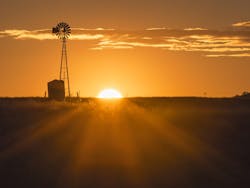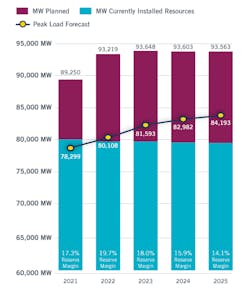Even in a pandemic, it seems the Texas electric grid can’t catch a break.
The grid operator for most of the state warned this week that the summer is likely to bring record-breaking peak demand for electricity, a situation that can threaten electric reliability and jack up prices.
It’s not unusual for the heavily air-conditioned state to use record amounts of electricity in the summer. But the prediction is surprising for this year because average electric demand is down due to the COVID-19 economic slump.
Heat, it turns out, may trump the slump, especially when coupled with the state’s population growth.
“We are anticipating a warmer than normal, or hotter than the normal summer,” said Peter Warnken, manager, resource adequacy at Electric Reliability Council of Texas (ERCOT), during a Thursday media briefing.
Will COVID-19 create a new phenomenon?
Last summer’s peak demand drove ERCOT power prices up to a $9,000/MWh cap compared with an average summer price of $30-35/MWh. ERCOT had to issue emergency alerts, calls to increase power production or lower energy use. It did not reach its highest alert level, however, which requires rotating blackouts.
Corey Amthor, president of Texas-based microgrid developer, Enchanted Rock, pointed to a potential phenomenon that could further strain the grid this summer.
Stay-at-home orders have shifted the grid’s dynamics with businesses using less power and residences using more as people work from home. But now, with the economy beginning to reopen, the summer may bring a combination of office openings with a sizable population still working from home and consuming energy there.
“There may be people still working in the home that might usually turn their thermostats up during the afternoon while they’re at work,” Amthor said in an interview with Microgrid Knowledge. “But yet offices, if they’re 25% occupied, they still have to have their air conditioners on, in most buildings. So it will be interesting to see how that plays out. I don’t think anybody knows for sure.”
Courtesy of ERCOT
On top of that the grid faces potential supply constraints. Extreme heat tends to put pressure on thermal power plants, increasing the likelihood they will need to shut down for repair. Meanwhile the Texas grid has become increasingly reliant on wind power. So if the wind doesn’t blow on a day when demand for electricity is high, the grid’s supply reserve could be found wanting.
The situation has made Texas a ripe market for microgrids, which provide power to facilities even when the grid is down and help them manage their electricity costs.
“We see a lot of industries that need backup, and want backup generation,” said Amthor.
Hospitals and microgrids
It isn’t only the state’s summer peak demand that is giving rise to more microgrids in Texas.
“There are many reasons for needing backup. The distribution grid experiences a lot of outages, some short term, some longer term in nature. It can be affected by mother nature, events, hurricanes. Power shortages in the summer are just one more piece of the pie,” Amthor said.
Amthor noted that COVID-19 has made healthcare and senior facilities particularly attuned to the importance of reliable power. Hospitals have emergency backup generators, but a majority do not have enough to backup their entire facility.
“So for the very short term, they can handle a power outage. But if that lasts more than two or three hours during the hot summer day, they have to evacuate their entire hospital,” he said. “That’s incredibly disruptive. When you’re in a COVID pandemic where social distancing is important, can you imagine what that would look like trying to join two hospitals together?”
Enchanted Rock has several microgrid projects in Texas, among them Citizens Medical Center, a hospital in Victoria, Texas, which has installed a 2.8 MW microgrid. But the company is perhaps best known in the state for the microgrids at H.E.B grocery stores.
Added Gregg Morasca, who is vice president, strategic customers for Schneider Electric, one of the most active microgrid builders nationwide: “Weather will continue to provide challenges to our electrical infrastructure. Whether it be hurricanes, wildfires or stretches of extreme heat, not only should resilience measures be put in place, energy alternatives should also be leveraged to manage costs. Microgrids put the power of localized resources to work to enable you to take control of your resilience and energy cost needs.”
Join Enchanted Rock, Schneider Electric and Veolia for a special discussion, “Disaster Planning & Business: How Microgrids Help Commercial & Industrial Operations Improve Customer Service in a Crisis,” at the Microgrid Knowledge Virtual Conference June 2. Registration is free.
Influence of DERs on the Texas grid
Because the Texas grid is gaining more microgrids, nanogrids, solar plus storage and other distributed energy resources, ERCOT is trying to inventory them so that it can begin to determine their influence on the grid.
“We have to revise all of our models and all of our systems to account for these technologies. We have a task force that’s looking at this. They’re drafting new rules on how to integrate these projects in the market, and how to operate them in a reliable fashion, and how to work with them with other resources,” said ERCOT’s Warnken. “So there’s a lot of activity going on there.”
And after this summer there may be a lot more — depending on the wind and weather.
Track news about the Texas microgrid market. Subscribe to the free Microgrid Knowledge newsletter.








